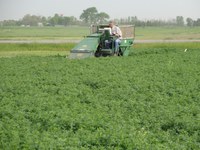Harvest Alfalfa at Right Time
(Click the image below to view a high-resolution image that can be downloaded)
Alfalfa is an important forage for dairy cows because it provides fiber that effectively stimulates chewing while providing energy and protein for milk production.
That means it needs to be harvested at the right time, according to North Dakota State University Extension Service dairy specialist J.W. Schroeder.
Recent warm weather and adequate moisture have the crop nearing the best time to harvest “dairy-quality” alfalfa, he notes. While not everyone needs dairy-quality alfalfa, dairy managers and those who seek to provide high-quality forage in that market need to get ready to harvest.
The harvest on alfalfa plots at the North Dakota Agricultural Experiment Station’s Main Station in Fargo began this week. Stands at Research Extension Centers to the west are about four to five days behind for every 150 miles they are from Fargo.
“As temperatures rise, the difference will shorten,” Schroeder says. “But when to harvest is your decision. However, if you want dairy quality, you better get on the stick. The stick I’m referring to is the PEAQ (predictive equations for alfalfa quality) stick. It’s not a new technique, but it is a low-cost, well-tested and reliable method to predict optimum dates for first cuttings by monitoring plant development and quality.”
The PEAQ method estimates fiber and relative feed value (RFV) based on the height of the tallest stem and the stage of plant maturity in a sampling area. Approximately 15 to 20 RFV units are lost during harvest and storage, so alfalfa needs to be cut at 165 to 170 RFV, as calculated using PEAQ, to have an RFV of 150 for harvested high-quality alfalfa forage. An RFV of 172 in the field equates to alfalfa 26 inches tall and in the bud stage.
Alfalfa at the Main Station grows about an inch a day. RFV can change 3 to 5 points per day in standing forage, so cutting may have to begin before alfalfa reaches a 165- to 170-PEAQ value.
PEAQ predictions are most accurate for good, healthy stands of pure alfalfa.
For dairy-quality alfalfa, the measure of fiber most commonly used to balance diets of lactating dairy cows is neutral detergent fiber (NDF). The optimum concentration of NDF for alfalfa is 40 percent, Schroeder says. Alfalfa containing 40 percent NDF allows reasonable grain concentrations in the diet while maintaining adequate NDF concentrations.
The protein concentration of alfalfa with 40 percent NDF is usually moderate (approximately 20 percent of dry matter), and additions of low-protein grains such as corn allow flexibility in diet formulation for ruminally undegraded protein while avoiding excessive protein concentrations.
“The first harvest is typically the highest yielding yet the most difficult crop to put up in a timely manner,” Schroeder says. “The PEAQ stick is a simple, effective tool to schedule your harvest to achieve forage-quality target levels. However, the method is not designed to balance rations and does not account for quality changes due to wilting, harvesting, storage or weather-related challenges.”
PEAQ sticks are available from the Midwest Forage Association at 4630 Churchill St., #1, St. Paul, MN 55126; by calling (651) 484-3888; or visiting http://www.midwestforage.org/peaq.pdf.
For more information about harvesting alfalfa, check out NDSU experts’ advice at http://www.ag.ndsu.nodak.edu/plantsci/forage/harvesttime.html.
NDSU Agriculture Communication
| Source: | J.W. Schroeder, (701) 231-7663, jw.schroeder@ndsu.edu |
|---|---|
| Editor: | Ellen Crawford, (701) 231-5391, ellen.crawford@ndsu.edu |


